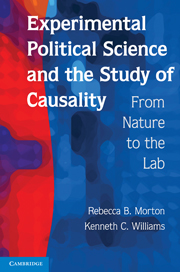Book contents
- Frontmatter
- Contents
- Acknowledgments
- I INTRODUCTION
- II EXPERIMENTAL REASONING ABOUT CAUSALITY
- 2 Experiments and Causal Relations
- 3 The Causal Inference Problem and the Rubin Causal Model
- 4 Controlling Observables and Unobservables
- 5 Randomization and Pseudo-Randomization
- 6 Formal Theory and Causality
- III WHAT MAKES A GOOD EXPERIMENT?
- IV ETHICS
- V CONCLUSION
- References
- Author Index
- Subject Index
5 - Randomization and Pseudo-Randomization
Published online by Cambridge University Press: 05 June 2012
- Frontmatter
- Contents
- Acknowledgments
- I INTRODUCTION
- II EXPERIMENTAL REASONING ABOUT CAUSALITY
- 2 Experiments and Causal Relations
- 3 The Causal Inference Problem and the Rubin Causal Model
- 4 Controlling Observables and Unobservables
- 5 Randomization and Pseudo-Randomization
- 6 Formal Theory and Causality
- III WHAT MAKES A GOOD EXPERIMENT?
- IV ETHICS
- V CONCLUSION
- References
- Author Index
- Subject Index
Summary
RCM-Based Methods and Avoiding Confounding
In the previous chapter we reviewed the methods used to estimate the effects of causes using control either through untested statistical assumptions about the relationships between observable and unobservable confounding variables, principally ignorability of treatment, or through the use of laboratory experimental designs that allow a researcher to set values of unobservables and observables directly or to control for them through repeated observations of subjects. We have also examined a number of studies using observational and experimental data, which have used control as a method of trying to discern the effect of changing voter information on voter behavior.
Suppose that, instead of trying to measure all the possible covariates that might confound the effect of information on voting decisions and then just assuming that the unobservables do not confound the effect or running an experiment in the laboratory where we are able to both control for observable and unobservable variables that affect the relationship between information and voting, we could find a variable that was related to the information levels of voters but independent of the choices voters make that depend on the information as well as the unobservables. That is, suppose we could find a variable or set of variables that are ignorable in the determination of Pj but have a consequential effect on T. Another way to think of the variable or set of variables in relationship to Pj is that they are redundant in the determination of the potential choices given information levels.
- Type
- Chapter
- Information
- Experimental Political Science and the Study of CausalityFrom Nature to the Lab, pp. 141 - 195Publisher: Cambridge University PressPrint publication year: 2010



